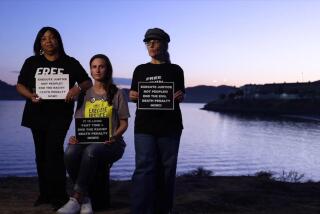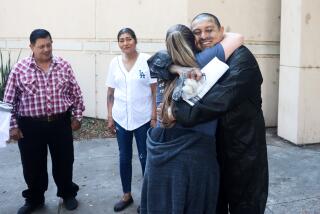Lazhanae Harris, 13 and on the run, was stabbed to death in L.A.
The loving attention that eluded Lazhanae Harris in life flooded the New Bethel Missionary Baptist Church at her funeral in March.
Family and friends, mostly youngsters, packed the South Los Angeles sanctuary that day and âall seemingly admired this girl,â recalled congregation clerk Myrna Smith.
âIt was the most amazing thing Iâve ever seen. They were all 12-, 13-, 14-year-old kids. And they were all crying.â
Days before, Lazhanae, 13, had been found in a rundown apartment in South Los Angeles, face down on a bloody mattress. Her femoral artery had been slashed.
Shunted from place to place for most of her life, she was left with no guardian but the Los Angeles County Department of Children and Family Services. The agency took her from her motherâs custody at age 3, placing her in a series of homes that didnât last.
Ten years later, Lazhanae became a sad statistic, one of at least 268 children to die between January 2008 and early August 2009 -- 76 by homicide -- despite having been under the agencyâs protection at some point, according to internal county documents.
Details of her life and death, pieced together from interviews and confidential agency records, crystallize the risks of bouncing from one stop to the next in the child welfare system, between foster care, group homes and other arrangements. Such children often run away, become homeless and fall victim to violence, experts say.
About 20,000 Los Angeles County youngsters are in âout of homeâ placements at any given time, and many are itinerant. Children with more than two years in the foster care system average more than five placements each. Some have more than 25 placements by the time they reach 18.
âThe more disruptions, the more they lack a sense of belonging, and that creates an urgent need to find a [new] place,â said Jacquelyn McCroskey, a professor of social work at USC. âIf the government doesnât provide one, the street provides some pretty awful alternatives.â
Given away
Before Lazhanae Renita Harris was born, her mother made informal arrangements to give her away.
Known as Lazha, she was the third of Shamana Johnsonâs nine children. Johnson said she gave eight to others.
Johnson âwas always sure she didnât want to raise her kids but never aborted any of them,â her mother, Anice Hendrix, said. âShe always gave birth and made sure they were placed in safe homes.â
âI just didnât want any of them to go into foster care,â Johnson, 33, said in the same interview. Sheâd had a difficult childhood herself as a dependent of the childrenâs services department. âAs you can see, when Lazha went to foster care, she ran away.â
At least five of Johnsonâs children ended up in the child welfare system, according to a confidential memo prepared by the department for the Board of Supervisors after Lazhanaeâs death. Kajuan, the one child she kept, died of asthma at 17 months, and two others were âunaccounted for,â according to the confidential memo. (The memo urged a fuller investigation into the toddlerâs 2006 death, which Hendrix said stemmed from a cold that progressed to pneumonia).
Lazhanae went to a family friend, Gwendolyn Snowden, when she was only weeks old. Snowden adopted her three years later, after social workers found Johnson unfit, citing a history of substance abuse and other problems.
But when Snowden later moved to Texas, she left Lazhanae behind with her biological family. Hendrix said the woman determined that the girl âwas too much to handle.â
Snowden continued, however, to cash the government checks for Lazhanaeâs care, the department report said. Social workers didnât learn of Lazhanaeâs abandonment by her adoptive mother until 2006, when Johnson was incarcerated for a hit-and-run conviction and left the girl with a cousin who lacked the means to care for her.
At that point, the department tried to reunite the girl with her adoptive mother, but Snowden was âunableâ to comply, the report said, without elaborating.
The department then placed Lazhanae in foster care with an aunt.
But in February 2008, the aunt cited âbehavioral problemsâ and asked the department to remove her, according to the memo to supervisors. The agency then put her in ânumerousâ other foster homes, the report said. Sometimes the paid caregivers exercised their right to have her removed; other times she ran away.
Each placement was worse than the one before it, family members said.
âThere was a really awful foster home on 106th,â said Hendrix, the grandmother. âIt had an odor that just would not go away. Full of filth. They would have her baby-sit the other kids. There was no door. It was just nasty.â
Even so, according to a pamphlet handed out to mourners at her funeral, Lazhanae was in some ways a normal kid, a middle-schooler with an âinfectious smile.â She was a cheerleader, dreamed of being a teacher and loved to sing and be with her cousins and friends, it said.
âShe always had something to say, and she had a way of telling you how she felt,â the pamphlet said, referring to her fondly as âSassy daughter.â
Seeking attention
According to the departmentâs memo, however, she had become increasingly difficult.
âShe wasnât looking for trouble,â Hendrix recalled. âShe was always just seeking the special attention she never had from her mom.â
While missing from a foster home in September 2008, Lazhanae was caught shoplifting and briefly placed on probation, the report said.
At 12, she was desperate for a change, relatives said. She learned last fall that her birth mother, Johnson, was being released from prison, and she ran away from her group home in hopes of joining her.
Initially, Johnson said, Lazhanae could not find her, so she âlived on the streets and waited.â Weeks later, they reunited, and for the first time in both of their lives, they attempted to assume the roles of mother and daughter. Lazhanae was 12; Johnson was 32.
âMy daughter did not want to go back [to the group home], and we didnât want to send her to school, because she knew that they would turn her in,â Johnson said.
Johnson recalled that their days often began tenderly, with Lazhanae saying, âMama, my stomach hurts. Can you rub my stomach?â Or, watching a TV commercial, âMama, can you buy me that Tinker Bell?â
Over time, Johnson said, Lazhanae became belligerent and her words turned sharper.
âShe could be very childlike one minute and then very adult the next, like she thought she was the mother in our relationship,â Johnson said.
In January, an anonymous caller to the child abuse hotline said Lazhanae and other foster children were being prostituted at truck stops near Fresno and Bakersfield, but the allegations were investigated and deemed unfounded, according to the department memo.
As winter changed to spring, Lazhanaeâs drive to be with her family seemed exhausted. At a Normâs restaurant, Johnson said, her daughter tossed food at patrons in a nearby booth. When her family scolded her, she stormed off, Johnson said.
Police say the girl wound up in Hollywood, where she met a group of adults who took her to the South Los Angeles apartment where she was killed.
âItâs not clear what she was doing in Hollywood,â Los Angeles Police Department Homicide Det. Sal LaBarbera said.
Preshae Bryan Tanner, 22, was charged in the murder and has pleaded not guilty. Tanner was romantically involved with a man who was staying at the apartment, police said.
A week before Lazhanae died, Samantha Hendrix, 42, the maternal aunt who had cared for Lazhanae previously, found her and took her to a McDonaldâs.
âShe was looking really down,â Hendrix said. â âAuntie, I want a change,â she told me. âI want to do something, do hair, go back to school.â I told her, âIf you truly want to change, I will help you.â â Lazhanae promised to call her, Hendrix said.
âThe next thing I knew, the coroner was knocking on the door,â she said.
More to Read
Sign up for Essential California
The most important California stories and recommendations in your inbox every morning.
You may occasionally receive promotional content from the Los Angeles Times.










